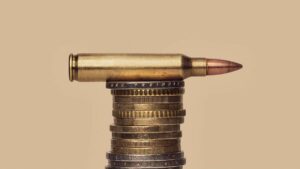These are the battery metals you didn’t know you were looking for

Pic: Bloomberg Creative / Bloomberg Creative Photos via Getty Images
Lead, zinc, tin and aluminium have been keeping a low profile compared to commodities such as lithium, gold or uranium that have been dominating the headlines recently.
However, they all have a role to play in the new economy and with ‘Dr Copper’ pointing to a recovery in the global economy, it’s worth a look to see where they are at now.
Lead: I was here first, whippersnapper
Unlike the other metals that we are examining, lead already sees use in the battery metals narrative, albeit for the much older (and more mature) lead-acid batteries that were first invented in 1860 rather than lithium-ion batteries that were first developed in 1985.
Most lead-acid batteries come in the form of the familiar and reliable 12 volt batteries found in cars.
And as Boab Metals (ASX:BML) managing director Simon Noon notes, most battery electric vehicles still use a 12V lead-acid batteries to power the starter, safety and auxillary functions along with the systems that manage the high voltage lithium-ion battery that powers the engine.
Notable examples of EVs that use the bog standard 12V lead-acid batteries are Tesla’s Model 3 and Model Y vehicles and Europe’s most sold EV in 2020, the Renault Zoe.
“So growth in demand for lead-acid batteries will be largely driven by growth in demand for traditional internal combustion (ICE) and electric vehicles,” Noon told Stockhead.
That’s a massive market given that there are about 1.5 billion vehicles in the global fleet as of 2020 and this is expected to grow to 2.1 billion by 2030 with about 10 per cent of that figure being EVs.
Some EV makers have indicated that they are looking at 12V lithium-ion batteries to replace lead-acid batteries, but Noon added that 70 to 80 per cent of the 12V battery market is in the form of battery replacement and the penetration of 12V lithium-ion technology is expected to be less than 2 per cent over the medium term.
Lead-acid batteries are also used in electric bikes, uninterruptible power supplies for hospitals, data centres and telcos as well as stationary energy storage for utilities and renewable energy generators.
No wonder then that the total market is forecast to grow by about US$10 billion over the next 10 years.
The maturity of lead-acid batteries is also telling in that nearly all the lead in them is reused in new batteries compared to the current rate of less than 5 per cent for lithium-ion batteries.
Tin: I’m still here
Next up on the list is tin, which is traditionally used to coat other metals to prevent corrosion or alloyed with copper to make bronze.
These days, about half of the tin consumed globally goes into solder for electronics while another modern use is in an alloy with niobium for superconducting magnets.
However, what isn’t as well known is that tin has been used as a performance enhancing component in battery anode materials.
Given its importance in modern electronics and its growing use in batteries, demand for tin has soared while supply remains constricted, sending its price up to a 10-year high of US$30,650 a tonne on May 18.
Inventory is also exceptionally low with the London Metals Exchange (LME) holding just 1,235t in its warehouses, according to Reuters.
Zinc: The old ways is best
Zinc is commonly used in galvanizing iron and steel against corrosion as well as in alloys.
And like lead, zinc has been used to produce zinc-carbon batteries for more than a century, though these are single-use items that generate a very familiar 1.5V.
Technology marches on and researchers have developed new zinc-air batteries that promise to outperform other commercially available battery technologies while being less harmful for the environment and more abundant.
Zinc is also used in zinc bromine batteries like those developed by Redflow (ASX:RFX).
These use a solution of zinc bromine that is stored in two tanks and pump through a reactor stack and back into the tanks when the battery is charged or discharged.
Zinc bromine batteries offer higher energy density when compared to lead-acid batteries, have no shelf-life limitations compared to other batteries and can be discharged completely on a daily basis, a good feature to have as they need to be fully discharged every couple of days.
Aluminium: More uses than you can shake a stick at
Aluminium has a wide variety of uses in everyday life with demand forecast by the Australian government to grow by 5.7 per cent in 2021 and by 3.9 per cent in 2022.
Prices for the silvery metal hit multi-year highs with Fastmarkets noting late last month that the three-month price had hit US$2,412 per tonne.
However, aluminium demand could increase if its potential as a substitute for copper is taken to heart.
Wood Mackenzie senior VP of metals and mining Julian Kettle pointed out that while aluminium’s conductivity is about 40 per cent lower than copper, its density is just 30 per cent of copper’s.
“This means that an aluminium cable is around 52% of the weight of a copper cable with the same conductivity, a property offering handling and installation benefits,” he noted.
“Too many forecasts ignore the fact that aluminium is a serious competitor to copper in a number of high volume applications, including high- and mid-voltage power cable, busbars, transformer windings and motor windings.”
Not exactly a battery metal, but like copper, the increasing use of EVs could see substantial demand boosts for aluminium wiring.
ASX small caps
The relative lack of attention on these commodities coupled with current excess supply as meant that development that development of new projects is a matter of incentive price and the ability to obtain some certainty on revenue.
Lions Selection Group executive director Hedley Widdup told Stockhead that future projects would likely have to overcome one or more known challenges that had kept the project in pipeline such as jurisdictional, technical or environmental.
With that thought, here are some small cap ASX companies that are focused on these commodities.
Boab Metals is currently working on the definitive feasibility study for its flagship Sorby Hills lead-silver-zinc project in Western Australia that has an overall resource of 44.9 million tonnes grading 3.2 per cent lead, 37 grams per tonne silver and 0.5 per cent zinc.
Noon told Stockhead that the company had achieved a number of significant milestones during the first half of 2021 including finalisation of its 4,800m Phase IV drilling program and a 56 per cent increase to its measured resource to 11.1Mt at 3.6 per cent lead, 0.3 per cent zinc and 45g/t silver.
“We are nearing completion of our DFS metallurgical test work program and look forward to reporting the results shortly.
“We have completed a preliminary round of discussions with a range of Tier-1 offtakers all who have indicated a strong demand for the Sorby Hills lead-silver concentrate.”
He added that the company has recently kicked off the +4,000m Phase V drilling campaign that will target a range of high-impact opportunities to materially increase the DFS mining inventory and test the blue-sky prospectivity of its adjacent Eight Mile Creek tenement.
“Looking forward, we will be receiving and incorporating the results of our metallurgical test work and Phase V drill programs into an updated mineral resource estimate and an investigation into expanding the project both in terms of production throughput and mine life,” Noon explained.
“We are looking to lock down binding term sheets with offtakers and commence construction contract tendering by the end of the year to support our ongoing discussions with Ffinanciers including Export Finance Australia (EFA) and the Northern Australia Infrastructure Facility (NIAF).
Boab remains on track to deliver a DFS early next year and move to a decision to mine during the second quarter of 2022.
The company recently brought its Plomosas plant into production at or better than its designed operating capacity.
Consolidated is currently processing ore at a rate of 200 tonnes per day using both the Plomosas and Aldama plants to reduce stockpiles of ore and build working capital.
It expects expansion of Plomosas from 100tpd to 200tpd to be completed by the end of this year.
Stellar continues to progress its Heemskirk tin project in Tasmania, which consists of four deposits defined over a total strike length of about 1,300m and to depths of almost 500m below surface.
The company is currently about to start its Phase 1 drill program that will target new areas of high-grade tin mineralisation and is reviewing the Phase 2 program that will include resource infill drilling and a deep hole targeting the main conduit of mineralising fluids at Heemskirk.
It is also reviewing other work needed to advance the project to pre and bankable feasibility studies.
Heemskirk currently has a resource of 6.6Mt grading 1.1 per cent tin, the highest grade undeveloped tin resource in Australia.
At Stockhead we tell it like it is. While Boab Metals is a Stockhead advertiser, it did not sponsor this article

UNLOCK INSIGHTS
Discover the untold stories of emerging ASX stocks.
Daily news and expert analysis, it's free to subscribe.
By proceeding, you confirm you understand that we handle personal information in accordance with our Privacy Policy.








